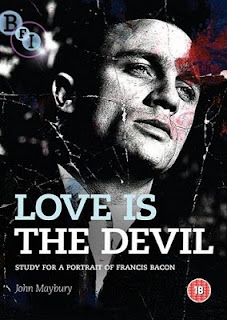Recently, I recommended some documentary DVDs on art and artists, but because Marcia keeps me on a short leash, I had no room then to talk about some of my favourite biopics. So let's take a look at a few of those movies - are you sitting comfortably? Then I'll begin:
Many of our older members will fondly remember those two popular dramas of yesteryear, Lust for Life (1956) and The Agony and the Ecstasy (1965) which dealt with Van Gogh and Michelangelo respectively.
Lust for Life starred Kirk Douglas as Vincent: a remarkable performance that netted him an Oscar nomination. He even looked like Vincent! Sadly, and to my mind unfairly, he was pipped at the post by Yul Brynner for The King and I. However, Anthony Quinn, who played Vincent's friend Paul Gauguin, did get an Oscar for his supporting role.
Lust for Life was filmed largely on location in France and is noted for its beautiful cinematography. Several art museums kindly allowed original works in their collections to be photographed. These, in addition to copies that were painted by Robert Parker, depicted Vincent's canvases in the movie. Altogether a beautiful and well-reasearched film.
The Agony and The Ecstasy, starring Charlton Heston as Micelangelo, is based on the eponymous novel by Irving Stone. Its focus is the stormy relationship between the artist and Pope Julius II, who commisssioned him to paint the Sistine chapel ceiling. Rex Harrison, fresh from My Fair Lady, played the Pope. My brain kept superimposing Raphael's sublime portrait of Julius II on the Harrison features. I didn't want to see Professor Higgins in a red robe discussing theology and art with Michelangelo.
The sets of the Papal and the Medici palaces are lavish and the costumes are beautiful - one gets a real sense of what Rome was like in the 16th century. I learnt a lot about the technique of fresco painting, too!
Still in Rome, we turn to Derek Jarman's Caravaggio. Derek Jarman requires a strong stomach at the best of times: he never shrinks from depicting the sordid details. The life and times of Caravaggio gave him lots of scope: sex, violence, crime, art, corruption - all grist to his mill. The central theme is Caravaggio's relationship with the urchin Ranuccio (Sean Bean) and the prostitute Lena (Tilda Swinton), who were his models and lovers. Jarman uses dramatic chiaruscuro lighting, so that the whole movie looks like Carvaggio's paintings and indeed recreates many of the famous works as tableaux vivants.
I recently saw Love is the Devil, directed by John Maybury, with Derek Jacobi giving a memorable and disturbing performance as Francis Bacon. Daniel Craig plays George Dyer, who came to burgle Bacon's apartment and stayed to become his lover, model and muse. Tilda Swinton, fresh from playing a prostitute in Caravaggio, puts in a creditable turn as the barmaid at Bacon's favourite pub, where he consorts with his dodgy friends.
The film is dark and unsettling, like Bacon's paintings. The artist's estate refused permission for any of Bacon's paintings to be shown in the film, but, as in the Caravaggio film, several scenes are recognisable as Bacon paintings. There are also other echoes of his work: Jacobi is often seen preening in a triple mirror, echoing the triptyches Bacon likes to paint; Maybury uses odd camera angles and distorted views to give the film the Francis Bacon look.
Pollock, directed by its star Ed Harris, tells the story of Jackson Pollock's last years, from his meeting with his future wife, painter Lee Krasner, until his death in a car accident at the age of 44.
Ed Harris devoted years to this project and learned to turn out credible drip paintings, almost indistinguishable from Pollock's own work. Harris, who bears a remarkable physical resemblance to the artist, convincingly depicts Pollock's struggle with depression and alcoholism and the passionate way he painted. This film left me with a new appreciation and understanding of the Pollock oeuvre!
But enough of the sordid tales of Caravaggio, Bacon and Pollock - let's have a look at the tranquil world of Jan Vermeer. Tracy Chevalier's novel The Girl With the Pearl Earring was beautifully filmed by Peter Webber in 2003 and the DVD is well worth another look even if you saw it on the big screen at the time.
What could be more delightful than the luminous Scarlett Johansson and the elegant Colin Firth (who, to me, will always have a whiff of Mr Darcy about him.) Every shot in the film has the Vermeer look and I was charmed by the scenes of Delft, a lovely town that looks today exactly as it did when Vermeer walked its cobbled streets.
Peter Greenaway's Nightwatching is an intriguing fictionalised account of the creation of The Night Watch by Rembrandt. Greenaway posits a fascinating conspiracy theory involving murder, rape and corruption among the leading Amsterdam families. Faintly echoing Dan Brown, he points out coded references to the conspiracy in each of the 34 characters depicted in the painting.
The film goes on to trace the downturn in Rembrandt's fortunes, leading to his eventual bankruptcy and death, all as a result of revenge by the aristos whose peccadilloes were revealed by the artist in his great painting.





No comments:
Post a Comment